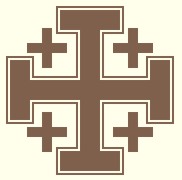![]()
![]()

THE CASTLES OF CILICIAN ARMENIA
Written by Gevork Nazaryan
The Kingdom of Cilician Armenia left a remarkable mark on the development of not only historical Armenia, but through direct contact with the Crusaders and later on the Crusader states, inspired the early culture of Medieval Europe in fields of social, economical, political, religious and as well as cultural spheres. Architecture [pentacle church domes, secular and as well as religious building], art, economy, laws, customs etc. were all shared with close of Cilician Armenia and Western Europe. By this period the Armenian people had accumulated the experience of the Armenian nation through the long millennia, from the ancient times of the kingdoms of Armani, Mitanni and Ararat [from the fourth to the second millenniums BC], when Armenian architecture was already at a very advanced level of development. Armenians of Ararat were by this time [second millennium BC] building, complex multistory secular as well as political and theistic buildings -- palaces and temples. Araratian colossal castles inspired the later castle building of the Orontid [Ervanduni], Artaxiad [Artašēsian], Arsacid [Aršakuni], Bagratid [Bagratuni] and as well as Cilician [Rubinian--Hetumian--Lusignan dynasties] periods.

COAT OF ARMS OF CILICIAN ARMENIA.
CROWNED RED LION RAMPANT UPON A GOLDEN SHIELD.

ENGRAVING OF THE RUINS OF THE CASTLE OF LAMBRON.
THE CASTLE WAS ONE OF IMPORTANT HET‛UMID
STRONGHOLDS.

THE GOLDEN SEAL OF KING LE[V]ON [LIT. LION]
THE MAGNIFICENT [1187-1219].
THE KING SEATED ON THE LION [FACING EAST AND WEST] THRONE.
ORB [EARTH/TERRESTRIAL/TEMPORALITY] IN HIS RIGHT HAND AND
FLEUR DE-LYS [HEAVEN/CELESTIAL/ETERNITY] SCEPTER IN HIS LEFT HAND.
WRAP AROUND INSCRIPTION -
ȺàÜ Â²¶²ôàð вÚàò
- LEON TAGAWOR HAYOC‘ - LEON
KING OF ARMENIA.

POŁ OF KING SMBAT I
[1296-1298]. OBVERSE: CROWNED KING ON HORSEBACK.
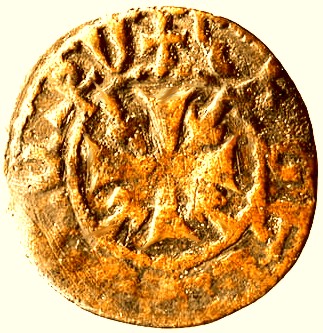
POŁ OF KING SMBAT I
[1296-1298]. OBVERSE: ORNATE CROSS PATTEE
WITH FLEUR-DE-LYS IN FOUR CORNERS.

COIN OF KING CONSTANTINE I [1298-1299].
OBVERSE: KING STANDING FACING, HOLDING SWORD AND SCEPTER.
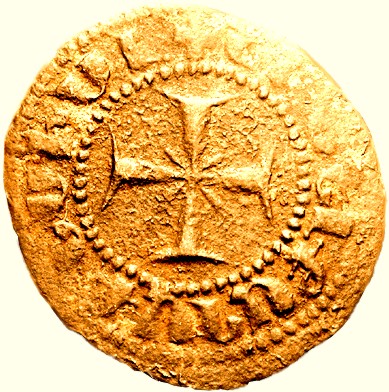
COIN OF KING CONSTANTINE I [1298-1299].
REVERSE: ORNATE [TAU] CROSS POTENT.
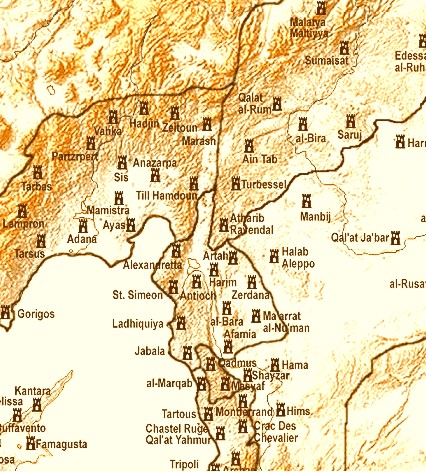
SOME OF THE MOST IMPORTANT CASTLES [OUT OF
HUNDREDS] OF CILICIAN ARMENIA
AND NEIGHBORING COUNTRIES THAT ACTED AS A FIRST LINE OF DEFENSE AGAINST
THE INVADING ARMIES. THE CASTLES WOULD OFTEN CHANGE HANDS AS THE TIDES
OF DESTINY TURNED UP AND DOWN.
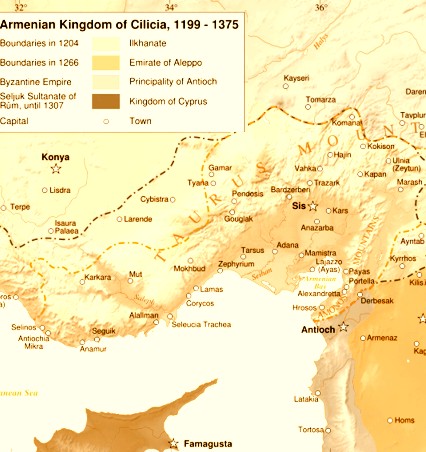
IMPORTANT CITIES, PORTS AND CASTLES OF CILICIAN ARMENIA.
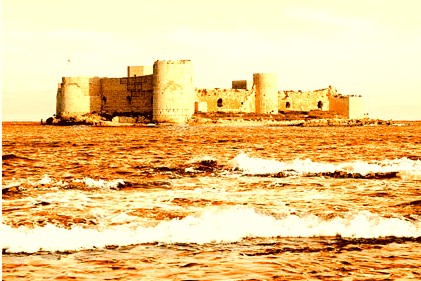
THE ISLAND-CASTLE OF KORYKOS [FACING THE MAINLAND WING OF
THE CASTLE].

OBVERSE SIDE OF THE COIN OF KING LEVON III (1270-1289).
THE CROWNED KING
ON HORSEBACK HOLDING THE DOUBLE-BAR
‡
CROSS IN HIS RIGHT HAND.
One of the greatest achievements that the Cilician Armenians had reached was the master craft of castle building, based upon the rich tradition of previous periods in Armenian history. The Crusaders acquired techniques of building round-shaped castles [previously to Crusade epoch most of the castles in Europe were square-shaped], for the most part advanced castle building in Europe began in the late Medieval period, in this respect the Cilician castles remain the best manifestations of the given time period in the XIth, XIIth and XIIIth centuries. The strategic selection of castle building in of itself is very complex and amazing. The castle, visible from miles away, represented the center and the power of the sovereign lord of the second estate [nobles, barons, viceroys, dukes] of the monarchial
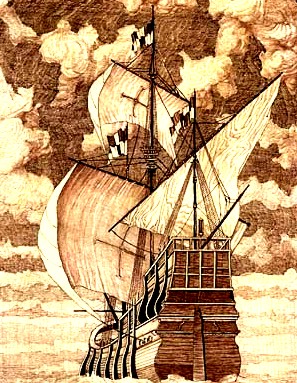
MANY CASTLES THROUGHOUT CILICIAN ARMENIA
WERE LOCATED THROUGHOUT THE PICTURESQUE
MEDITERRANEAN COASTLINE SERVING AS VERY IMPORTANT
INTERNATIONAL PORTS OF TRADE AND COMMERCE.

Æ POŁ
OF KING LEVON VI [LEO V - 1373-1375] LUSIGNAN.
OBVERSE: LION ADVANCING RIGHT. REVERSE: CROSS PATTEE.

LION/SPHINX WITH THE STAFF OF DIVINITY
┴
[TAU - DOWNWARD -
ON THE VERTICAL POLE FORMING THE AXIS MUNDI/TREE OF LIFE]
THE ROYAL ESCUTCHEON OF THE ARMENIAN KINGS.
hierarchy, his right of holding of the domain, a fief granted personally by the orders of the King himself for the duties and tasks accomplished in the name of the king and country. Natural obstacles like rocky terrain unrelenting cliffs; canyons guarded most of the castles, while rivers and lakes served as excellent obstacles in terms of natural moat entrenchment. The enormous and complex castles of the Kingdom of Cilician Armenia are one of the greatest and distinguished highpoint attainments in the history of Cilician Armenia.
